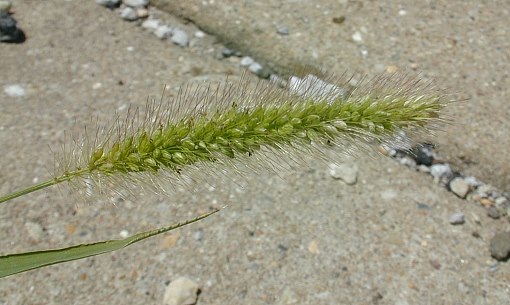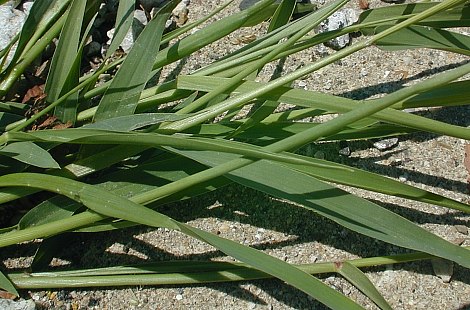Description: This grass is a summer annual that branches at the base to form a small tuft of leafy culms. In open areas, the slender culms are erect, ascending, or widely spreading; they are 1½–2' long, terete, light green, and hairless. The blades of the alternate leaves are up to 6" long and ½" across; they are light to medium dull green and hairless. Their margins are usually flat and entire, occasionally curving upward and becoming minutely wavy. The open sheaths are light to medium green like the leaves, but slightly more shiny; they wrap around the culms loosely. At the base, the sheaths are often purplish, while their margins are ciliate. At the junction of each blade and sheath, the ligule is defined by a ring of white hairs.

Each culm
terminates in a spike-like panicle of florets about 2-4" long and ½"
across. The light green panicle has a dense and cylindrical appearance;
it is either straight or slightly nodding. The exterior of each panicle
is surrounded with ascending bristles that are light green or purple.
The lateral branches of the panicle are very short, terminating in
individual spikelets. Each fertile spikelet consists of a single
floret, a pair of lemmas, and a pair of tiny glumes at the bottom; it
is 1.5–2.5 mm. in length (excluding the bristles, which are 3-5 times
longer). Each spikelet has 1-3 bristles; these bristles originate from
an area directly underneath the spikelet. One lemma extends the full
length of the spikelet, while the other lemma is about one-half the
length of the spikelet. Some spikelets may fail to produce any florets
or grains. The blooming period can occur from late spring to early
fall, but lasts only 1-3 weeks for each plant. The florets are
wind-pollinated. Each fertile floret produces a single grain about 1.5
mm. long and half as much across. Individual grains are ovoid in shape,
flattened on one side, tapered at both ends, and
bone-colored to pale
brown. The grains fall from the seedhead when they are ripe, while the
bristles remain attached. The root system is shallow and fibrous. This
grass reproduces by reseeding itself.
at both ends, and
bone-colored to pale
brown. The grains fall from the seedhead when they are ripe, while the
bristles remain attached. The root system is shallow and fibrous. This
grass reproduces by reseeding itself.
Cultivation:
This weedy grass is found in full to partial sun, moist to dry-mesic
conditions, and many kinds of soil, including those containing loam,
clay, and gravel. After the seeds germinate, this grass develops very
quickly. It is can produce several generations of plants in a single
growing season.
Range & Habitat:
The non-native Green Foxtail is very common in Illinois; it is found in
every county.
Habitats include cropland, fallow fields, pastures, gravelly areas
along roads and railroads, cracks in urban parking lots and sidewalks,
vacant lots, gardens and lawns, barren areas of mined land, and open
waste areas. This grass prefers highly disturbed areas where bare
ground has been exposed. It does not invade high quality natural areas
to any significant extent.
Faunal Associations:
Various insects feed on Green Foxtail and other weedy Setaria
spp.
These species include grasshoppers, flea and leaf beetles,
aphids,
stinkbugs, and the seed-eating larvae of a gall fly (see Insect
Table). Upland gamebirds, songbirds, and even some wetland
birds eat the seeds of these grasses (see Bird Table).
To some of these species (especially the smaller songbirds), the weedy Setaria
spp. are preferred as a source of food. It is possible that
some seeds are able to pass through the gullets of birds and remain in
a viable state; this may explain the rapid spread of these weedy
grasses across North America. Some mammals also utilize these grasses
as a source of food. The Prairie Deer Mouse (Peromyscus
maniculatus bairdi), White-Footed Mouse (Peromyscus
leucopus), wild House Mouse (Mus musculus),
and Thirteen-Lined Ground Squirrel (Citellus tridecemlineatus)
eat the seeds, while the Prairie Vole (Microtus ochrogaster)
has been observed to feed on both the leaves and seeds. Cattle and
other domesticated grazing animals will eat the foliage of young
plants; the Cottontail Rabbit also eats the foliage to some extent.
Photographic Location:
The photographed plant was growing from a crack in a city sidewalk in
Urbana, Illinois.

Comments: This weedy grass is ubiquitous and can appear just about anywhere. Among the weedy Setaria spp., it is the first one to develop its seedheads and bloom (sometimes as early as late spring). However, later generations of plants will bloom later in the year. Green Foxtail is fairly easy to identify. It is usually a medium-small grass with squiggly light green seedheads; the bristles of young seedheads are either light green or purple (purple bristles seem to be more common during cool weather). These seedheads are fairly straight and there are only 1-3 bristles that originate from underneath each tiny spikelet. Other weedy Setaria spp. have nodding seedheads (Setaria farberi) or seedheads with yellow bristles (Setaria glauca). Furthermore, they often have either 4-12 bristles or only 1 bristle per spikelet. Another common name of Setaria viridis is Green Bristlegrass.